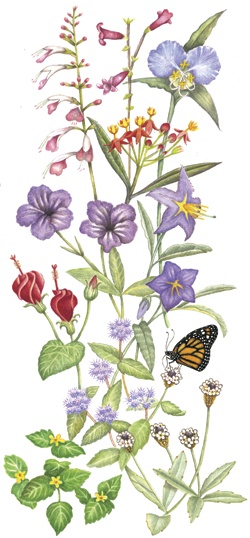They grew in dense, tall thickets that blanketed the vacant fields around our suburban home in Corpus Christi. As a child, I spent hours playing in those common sunflowers, mashing down trails, building forts and hiding out with other neighborhood kids.
Weeds. That’s what they were, of course. Undesirables that would never fit in with the wax-leaf ligustrum, variegated pittosporum, Chinese tallows and carpet grass that dominated our yard in the 1960s. With grudging help from me and my brother, Dad regularly mowed, trimmed and fertilized that big lawn, a project that typically took most of a hot, muggy afternoon.
To this day, I still hate wax-leaf ligustrum. With a vengeance. I’ll never forget the countless hours I spent cutting its leggy branches into neat hedges, picking up the piles of clippings and depositing them in the same field where the sunflowers thrived. In other words, they created too much work, the antithesis of a happy childhood.
Or so I thought then. Now that I’m wiser (though not much older, mind you), I despise the ligustrum—some call it “disgustrum” for a loftier reason: It’s highly invasive and to be avoided at all costs. For that matter, so are Chinese tallows, pyracantha (another resident of our ’60s yard) and dozens of other species. Sure, we have a few forbidden plants established in our yard (they came with the house, you see). But as certified Texas Wildscapers through the Texas Parks and Wildlife Department, my husband, James, and I adhere to the program’s No. 1 priority as much as we can: Plant at least 50 percent or more Texas natives.
Into our third year of wildscaping, we’re amazed to see how our once-plain yard has transformed into a wildlife habitat that attracts more and more critters. Monarch butterflies hover over the blue mistflowers, sometimes depositing eggs on nearby butterfly weeds. In a tall clump of red Turk’s cap, two anoles (lizards) secretively share quarters, now and then hanging out on our Wildscape sign. Last summer, a mysterious hole the diameter of a quarter appeared in our brushy sanctuary (left wild for protective cover). A bit of research turned up the chubby digger’s name: an ox beetle (Strategus aloeus).
I’ve enjoyed learning so much about nature. Thanks to the Internet, I can look up (or e-mail an expert) my questions about insects, plants, animals and gardening dilemmas (I decided to let the oleander aphids on our butterfly weed win). On my blog, “Window on a Texas Wildscape,” I share what I learn, plus photos of flowers, bugs, spiders, current projects and more. I even write up adventures when they happen. Last summer, for instance, we rescued three orphaned eastern fox squirrels. Miraculously, I even coaxed the last one down from 30 feet up in our live oak!
All this is to say that these days whenever I’m out in our yard, I look at the ground with different eyes. Once, I yanked and pulled whatever I deemed uninvited. Scraggly grasses, strange plants about to bloom, strange plants in bloom, bushy ground covers, you name it. If I (or someone else before me) didn’t put them there, then they must be weeds. Right?
Now I question. Now I investigate.
“Want me to pull this up?” James asked one evening as we surveyed the pink and red blooms of our prolific Salvia coccinea (Coral Nymph and Lady in Red).
“Let’s wait and see what the flowers look like,” I replied, already curious. When the lavender, trumpet-shaped flowers appeared, I thumbed through Wildflowers of Texas and solved the mystery: violet ruellia (Ruellia nudiflora). Sometimes called wild petunia, the flowers of this species bloom at sunrise, then fall off in early afternoon.
The plant stayed. So did several more I spotted in the sanctuary.
When another species of purple flowers showed up in a field across the street, I snapped photos, then returned to the wildflower book. Hmm, a silverleaf nightshade (Solanum elaeagnifolium), listed on the Texas toxic plant database. Just a few days later, I noticed an uninvited guest with familiar-looking yellow flowers in our withering vegetable garden. Another photo, another investigation. Turns out the buffalo bur (Solanum rostratum) and silverleaf nightshade belong to the same family, Solanaceae.
James offered to transplant the prickly buffalo bur (so named because its spiny fruit once stuck to the hides of roaming buffalo). Ultimately, we let it stay.
Our interest in native plants naturally led us to the Lady Bird Johnson Wildflower Center, where we spent a hot July afternoon. After the field trip, we planted rock penstemons (Penstemon baccharifolius) and blackfoot daisies (Melampodium leucanthum), both hardy Texas species we’d admired growing at the center. But what absolutely stunned me during our visit was seeing something I’d considered a weed nearly all my life actually showcased.
“That’s a plant?” I said, staring at the sign, completely dumbfounded. Heck, I’d never even considered the thought of it having a name. Back at home, I got out my book and learned that Texas frogfruit (Phyla incisa) makes an excellent ground cover. Plus, larvae of the phaon crescent (butterfly) eat the leaves. Wow. Fascinating!
Which leads me to another weed-turned-plant in our wildscape—horse herb (Calyptocarpus vialis). Two summers ago, I yanked up the green stuff with tiny yellow flowers by the droves to make way for a patch of grass I’d rooted. “Weed, weed, weed,” I’d mutter as I worked. Then drought hit last summer, and what bounced back first when the rains came? That weed! But by then, I’d done some research. Depending on your viewpoint, horse herb either makes a great ground cover … or it takes over everything where it shouldn’t.
Needless to say, I asked James to go easy when he mowed over the horse herb. And could he please also watch out for the whitemouth dayflowers (Commelina erecta) with the little blue blossoms? They’re not a weed, you know.
Well, at least, not any more.
——————–
Sheryl Smith-Rodgers writes about life and nature for Texas Co-op Power.


